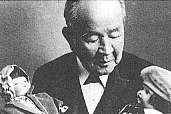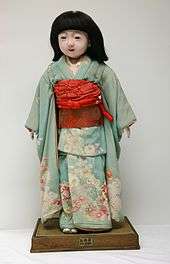Japanese friendship dolls
Japanese friendship dolls (友情人形, yūjō ningyō) or Japanese ambassador dolls and the American blue-eyed dolls (青い目の人形, aoi me no ningyō) were programs of goodwill between Japan and the United States. American Sidney Gulick, a missionary in Japan, initiated an exchange of dolls between children as a way to ease cultural tensions in the 1920s. Japanese Viscount Eiichi Shibusawa responded by initiating a program to send 58 dolls to American museums and libraries.

A similar concept is the Kokeshi doll.
Overview
The Immigration Act of 1924 prohibited East Asians from immigrating to the United States, which increased tension between the US and Japan. Dr. Sidney Gulick was a former missionary who spent time in Japan between 1888 and 1913. He was familiar with how important dolls are in Japanese culture, and to promote goodwill between the countries he initiated a program to send dolls from the US to children in Japan.[1] Gulick participated in forming a group called the Committee on World Friendship Among Children. In 1927, the first project was to organize the sending of 12,739 friendship dolls, also known as American blue-eyed dolls to Japan. These dolls arrived in time for Hinamatsuri, the annual Japanese doll festival.
Inspired by this act of goodwill, Viscount Eiichi Shibusawa led a collection in Japan to reciprocate for this gift. The best doll makers in Japan were commissioned to produce 58 friendship dolls. Each doll was 32-33 inches tall and were dressed in beautiful kimonos made of silk. Each doll also came with unique accessories. These Japanese friendship dolls represented specific Japanese prefectures, cities or regions. The dolls were sent to libraries and museums throughout the United States.
Denny Gulick, grandson of Sidney, has tried to revive the doll exchange idea.[2]
List of friendship dolls

Over the years, a few dolls were lost or are missing, but many are still on display today. Those whose locations are known include:
- Miss Aichi, sent to Nashville, Tennessee, was lost for decades but rediscovered in 2014 and returned to Japan
- Miss Akita at the Detroit Children's Museum in Detroit
- Miss Aomori, in a private collection
- Miss Chiba, sent to Riverside, California, present location unknown
- Miss Chosen at the Brauer Museum of Art in Valparaiso, Indiana
- Miss Dai Nippon (Miss Japan) at the Department of Anthropology, National Museum of Natural History, Smithsonian Institution in Washington, D.C.
- Miss Ehime, at Gulfport, Mississippi, destroyed in Hurricane Camille and replaced in 1988
- Miss Fukui, sent to Salt Lake City, present location unknown
- Miss Fukuoka at the Jordan Schnitzer Museum of Art in Eugene, Oregon
- Miss Fukushima, sent to Houston, now in a private collection
- Miss Gifu at the Cleveland Museum of Art in Cleveland
- Miss Gunma, sent to Brooklyn, now at the Morikami Museum and Japanese Gardens in Delray Beach, Florida
- Miss Hiroshima at the Baltimore Museum of Art in Baltimore
- Miss Hokkaido at the Putnam Museum of History and Natural Science in Davenport, Iowa
- Miss Hyogo at the St. Joseph Museum in Saint Joseph, Missouri[3]
- Miss Ibaraki (Tsukuba Kasumi) at the Milwaukee Public Museum in Milwaukee - the Messenger of Friendship[4] is again on display due to the tsunami and earthquake in Japan
- Miss Ishikawa at that Montana Historical Society in Helena, Montana
- Miss Iwate at the Birmingham Public Library in Birmingham, Alabama[5]
- Miss Kagawa at the North Carolina State Museum of Natural Sciences in Raleigh, North Carolina
- Miss Kagoshima at the Phoenix Museum of History in Phoenix, Arizona
- Miss Kanagawa, sent to Eugene, Oregon, present location unknown
- Miss Kanto-shu, sent to Manchester, New Hampshire, now in a private collection
- Miss Karafuto, sent to Wilmington, Delaware, confused with Miss Nagano
- Miss Kobe-shi, sent to Stamford, Connecticut, present location unknown
- Miss Kochi at the Carnegie Museum of Natural History in Pittsburgh
- Miss Kumamoto, sent to New Orleans, present location unknown
- Miss Kyoto-fu at Boston Children's Museum in Boston
- Miss Kyoto-shi at the Arkansas Museum of Discovery in Little Rock, Arkansas
- Miss Miyazaki, at the Hennepin County Library in Minneapolis, Minnesota
- Miss Mie at the University of Nebraska State Museum in Lincoln, Nebraska
- Miss Miyagi, sent to Topeka, Kansas, now in a private collection
- Miss Nagano, sent to Providence, Rhode Island, now at the Delaware Historical Society in Wilmington, Delaware
- Miss Nagasaki (Tamako)[6] at the Rochester Museum and Science Center[7] in Rochester, New York
- Miss Nagoya-shi at the Atlanta History Center in Atlanta
- Miss Nara at the Idaho Historical Museum in Boise, Idaho
- Miss Oita at the Springfield Science Museum in Springfield, Massachusetts
- Miss Okayama at the North Dakota State University Textile Collection in Fargo, North Dakota
- Miss Okinawa at the Cincinnati Art Museum in Cincinnati
- Miss Osaka-fu, sent to Newark, New Jersey, now at the Ohio Historical Society in Columbus, Ohio
- Miss Osaka-shi at the Newark Museum in Newark, New Jersey
- Miss Saga, sent to Philadelphia, present location unknown
- Miss Saitama at the Charleston Museum in Charleston, South Carolina
- Miss Shiga, sent to Miami, present location unknown
- Miss Shimane at the Children's Museum of Indianapolis in Indianapolis[8]
- Miss Shizuoka at the Kansas City Museum in Kansas City, Missouri
- Miss Taiwan at the Natural History Museum of Los Angeles County in Los Angeles
- Miss Tochigi, sent to Charleston, West Virginia, present location unknown
- Miss Tokushima at the Northwest Museum of Arts and Culture in Spokane, Washington
- Miss Tokyo-fu, sent to Richmond, Virginia, present location unknown
- Miss Tokyo-shi, sent to New York City, present location unknown
- Miss Tottori at the Museum of the South Dakota State Historical Society in Pierre, South Dakota
- Miss Toyama at the Speed Art Museum in Louisville, Kentucky
- Miss Wakayama at the Nevada Historical Society in Reno, Nevada
- Miss Yamagata at the Maine State Museum in Augusta, Maine
- Miss Yamaguchi, sent to Chicago, now at the Museum of International Folk Art in Santa Fe, New Mexico[1]
- Miss Yamanashi at the Wyoming State Museum in Cheyenne, Wyoming
- Miss Yokohama-shi, at the Denver Public Library through the 1990s when it was entrusted to Denver Museum of Miniatures, Dolls and Toys after being restored
American Blue-eyed dolls
In 1927, children in the United States sent over 12,000 Friendship Dolls to Japanese elementary school children as a gesture of friendship. Dolls were donated by churches and schools around the country and suggested to have a "Mama voice" and cost not more than $3.00. Each doll was sent with a message including the name of the doll, the names of the givers and the address for the "thank you" letter. Dolls were given farewell parties and given "passports" that cost 1 cent and "railroad and steamer tickets" that cost 99 cents. It was suggested that "girls specialize on the selection of the dolls and the making of their clothing and that boys serve as business and ticket agents." Dolls were also accompanied with a poem written by Robert Underwood Johnson titled Friends Across the Sea which was written at the request of the Committee of World Friendship among Children. Less than 100 of the dolls were sent to Formosa and divided amongst the ethnically segregated Elementary schools and kindergartens. Displayed with their own passport, only 334 dolls survived WWII and are now are preserved with the best care in Japan.
References
- "Moifa - About the Collections - Miss Yamaguchi Japanese Ambassador Doll". Archived from the original on 2009-04-19.
- "Denny Gulick, Ph.D". East Asian Scient and technology web site. University of Maryland. Archived from the original on June 13, 2010. Retrieved May 7, 2010.
- "Japanese Friendship Dolls" (PDF). St. Joseph Museum (St. Joseph, Missouri) web site. July 2008. Archived from the original (PDF) on July 24, 2011. Retrieved May 7, 2010.
- http://www.mpm.edu/exhibitions/featured/friendshipdoll/
- "Birmingham Public Library - Miss Iwate".
- Gian Carlo Cervone. "[RMSC Collections Department] Nagasaki Tamako".
- "Rochester Museum & Science Center—Rochester, NY".
- Jennifer Messmer. "The Secrets of Our Collection - The Children's Museum of Indianapolis". Archived from the original on 2013-03-09.
External links
- Dolls of friendship; the story of a goodwill project between the children of America and Japan, by Committee on World Friendship Among Children. New York, Friendship Press 1929
- Miss Ibaraki at the Milwaukee Public Museum
- Entry on Miss Japan in the online artifact catalogue of the Department of Anthropology, National Museum of Natural History, Smithsonian Institution
- A Mission of Friendship at the Japanese American National Museum
- Milwaukee doll stars in Japan relief effort - April 27, 2011
- The Friendship Doll by Kirby Larson - published on May 10, 2011